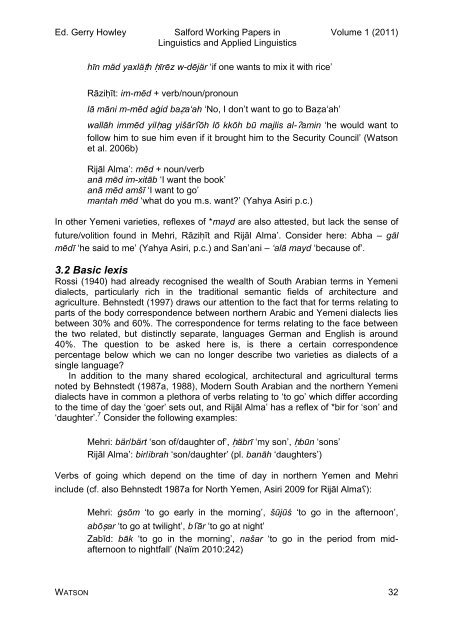South Arabian and Yemeni Dialects
South Arabian and Yemeni Dialects
South Arabian and Yemeni Dialects
You also want an ePaper? Increase the reach of your titles
YUMPU automatically turns print PDFs into web optimized ePapers that Google loves.
Ed. Gerry Howley Salford Working Papers in<br />
Linguistics <strong>and</strong> Applied Linguistics<br />
hīn mäd yaxläṭh ḥīrēz w-dējär ‘if one wants to mix it with rice’<br />
Rāziḥīt: im-mēd + verb/noun/pronoun<br />
lā māni m-mēd aġid baẓa‘ah ‘No, I don’t want to go to Baẓa‘ah’<br />
Volume 1 (2011)<br />
wallāh immēd yilḥag yišārʕōh lō kkōh bū majlis al-ʔamin ‘he would want to<br />
follow him to sue him even if it brought him to the Security Council’ (Watson<br />
et al. 2006b)<br />
Rijāl Alma‛: mēd + noun/verb<br />
anā mēd im-xitāb ‘I want the book’<br />
anā mēd amšī ‘I want to go’<br />
mantah mēd ‘what do you m.s. want?’ (Yahya Asiri p.c.)<br />
In other <strong>Yemeni</strong> varieties, reflexes of *mayd are also attested, but lack the sense of<br />
future/volition found in Mehri, Rāziḥīt <strong>and</strong> Rijāl Alma‛. Consider here: Abha – gāl<br />
mēdī ‘he said to me’ (Yahya Asiri, p.c.) <strong>and</strong> San’ani – ‘alā mayd ‘because of’.<br />
3.2 Basic lexis<br />
Rossi (1940) had already recognised the wealth of <strong>South</strong> <strong>Arabian</strong> terms in <strong>Yemeni</strong><br />
dialects, particularly rich in the traditional semantic fields of architecture <strong>and</strong><br />
agriculture. Behnstedt (1997) draws our attention to the fact that for terms relating to<br />
parts of the body correspondence between northern Arabic <strong>and</strong> <strong>Yemeni</strong> dialects lies<br />
between 30% <strong>and</strong> 60%. The correspondence for terms relating to the face between<br />
the two related, but distinctly separate, languages German <strong>and</strong> English is around<br />
40%. The question to be asked here is, is there a certain correspondence<br />
percentage below which we can no longer describe two varieties as dialects of a<br />
single language?<br />
In addition to the many shared ecological, architectural <strong>and</strong> agricultural terms<br />
noted by Behnstedt (1987a, 1988), Modern <strong>South</strong> <strong>Arabian</strong> <strong>and</strong> the northern <strong>Yemeni</strong><br />
dialects have in common a plethora of verbs relating to ‘to go’ which differ according<br />
to the time of day the ‘goer’ sets out, <strong>and</strong> Rijāl Alma‛ has a reflex of *bir for ‘son’ <strong>and</strong><br />
‘daughter’. 7 Consider the following examples:<br />
Mehri: bär/bärt ‘son of/daughter of’, ḥäbrī ‘my son’, ḥbūn ‘sons’<br />
Rijāl Alma‛: bir/ibrah ‘son/daughter’ (pl. banāh ‘daughters’)<br />
Verbs of going which depend on the time of day in northern Yemen <strong>and</strong> Mehri<br />
include (cf. also Behnstedt 1987a for North Yemen, Asiri 2009 for Rijāl Almaʕ):<br />
Mehri: ġsōm ‘to go early in the morning’, šūjūś ‘to go in the afternoon’,<br />
abōṣar ‘to go at twilight’, bʕār ‘to go at night’<br />
Zabīd: bāk ‘to go in the morning’, našar ‘to go in the period from midafternoon<br />
to nightfall’ (Naïm 2010:242)<br />
WATSON 32
















